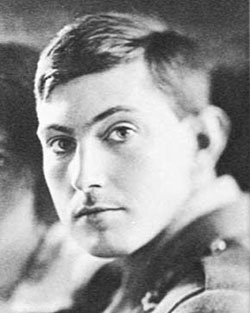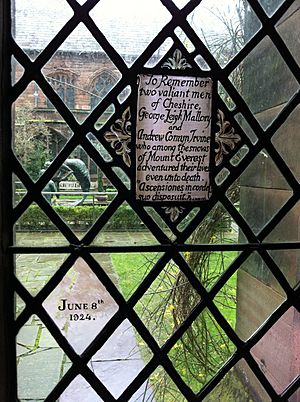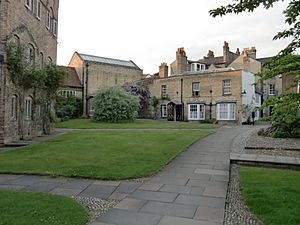George Mallory facts for kids
Quick facts for kids
George Mallory
|
|
|---|---|

Mallory in 1915
|
|
| Born |
George Herbert Leigh Mallory
18 June 1886 Mobberley, Cheshire, England, UK
|
| Died | 8–9 June 1924 (aged 37) North Face, Mount Everest, Tibet
|
| Cause of death | Mountaineering accident |
| Body discovered | 1 May 1999 |
| Alma mater | Magdalene College, Cambridge |
| Occupation | Teacher, Mountaineer |
| Spouse(s) |
Ruth Dixon Turner
(m. 1914–1924) |
| Military career | |
| Allegiance | United Kingdom |
| Service/ |
British Army |
| Years of service | 1915–1918 |
| Rank | Lieutenant |
| Battles/wars | World War I |
George Herbert Leigh Mallory (born June 18, 1886 – died June 8 or 9, 1924) was a famous English mountaineer. He was part of the first three British trips to Mount Everest in the early 1920s.
Mallory was born in Cheshire, England. He went to Winchester College, where a teacher helped him discover his love for climbing in the Alps. After college at Magdalene College, Cambridge, he taught at Charterhouse School. He kept improving his climbing skills in the Alps and the English Lake District. During the First World War, he served in the British Army and fought in the Battle of the Somme.
After the war, Mallory joined the first British expedition to Mount Everest in 1921. In 1922, he was part of a second trip to climb the world's highest mountain. His team reached a record height of 8,225 meters (26,985 feet) without extra oxygen. A reporter once asked him why he wanted to climb Everest. Mallory famously replied, "Because it’s there."
During the 1924 expedition, Mallory and his climbing partner, Andrew "Sandy" Irvine, disappeared on Everest. They were last seen about 245 meters (800 feet) from the top. Mallory's body was found 75 years later, on May 1, 1999, by a research team. It is still a big mystery whether Mallory and Irvine reached the summit before they died.
Contents
Early Life and Learning
Growing Up and School
George Mallory was born in Mobberley, Cheshire. His father, Herbert Leigh-Mallory, was a clergyman. His mother, Annie Beridge, was also the daughter of a clergyman. George had two sisters and a younger brother, Trafford Leigh-Mallory, who became a famous commander in World War II.
When he was 10, George went to a boarding school in Eastbourne. At 13, he won a scholarship to Winchester College. There, a teacher named R. L. G. Irving introduced him to rock climbing and mountaineering. Irving often took students climbing in the Alps.
College and Teaching
In 1905, Mallory started studying history at Magdalene College, Cambridge. He was also a very good oarsman for his college. At Cambridge, he became friends with famous writers and artists.
After college, Mallory wrote an essay called Boswell the Biographer. In 1910, he began teaching at Charterhouse School. One of his students was the poet Robert Graves. Graves later wrote that Mallory was a kind teacher who helped him with his interest in books and poetry, and also taught him climbing.
While teaching, Mallory met Ruth Turner. They got married in 1914, just before the First World War began. George and Ruth had two daughters, Frances and Beridge, and a son, John.
Serving in the War and Returning to Everest
In 1915, Mallory joined the British Army as a second lieutenant. He fought in France during the First World War, including the Battle of the Somme. He left the army in 1920.
After the war, Mallory went back to Charterhouse School. But he soon left to join the first British trip to Mount Everest in 1921. Between expeditions, he tried to earn money by writing and giving talks. In 1923, he became a lecturer at Cambridge University. He was given time off to join the 1924 Everest expedition.
Mallory's Amazing Climbs
Climbing in Europe
In 1910, Mallory tried to climb Mont Vélan in the Alps but had to turn back because of altitude sickness. In 1911, he successfully climbed Mont Blanc. He also made the third climb of the Frontier ridge of Mont Maudit.
By 1913, Mallory had climbed Pillar Rock in England's Lake District without any help. This route is now called "Mallory's Route" and was one of the hardest climbs in Britain for many years.
Exploring Mount Everest

Mallory was part of the first 1921 British Mount Everest reconnaissance expedition. This trip was organized to find ways to climb Everest. Mallory and his team created the first accurate maps of the area around the mountain. They explored different paths to the peak.
Mallory's group, with the help of Sherpas, climbed several smaller peaks near Everest. They were likely the first Westerners to see the Western Cwm, a valley at the base of the Lhotse face. They also mapped the Rongbuk Glacier, which leads to the North Face of Everest. By climbing to the North Col (7,020 meters or 23,031 feet high), they found a route to the summit.
In 1922, Mallory returned to the Himalayas for a serious attempt to reach the summit. Mallory, along with Howard Somervell and Edward Norton, climbed without extra oxygen. They reached a record height of 8,225 meters (26,985 feet) before bad weather forced them back. Another team, led by George Finch, reached an even higher point using bottled oxygen. This showed Mallory how helpful oxygen could be.
Mallory led a third attempt in 1922, but it was unsuccessful. On June 7, 1922, an avalanche swept over his group, killing seven Sherpas. The climb was stopped, and some people criticized Mallory's decisions.
Mallory's famous quote, "Because it's there," came from an interview about climbing Everest. This phrase is now one of the most famous in mountaineering history.
Mallory's Last Climb
The 1924 Everest Expedition
Mallory joined the 1924 Everest expedition. He was 37 years old and felt this would be his last chance to climb the mountain. He even told people in the US that the expedition would reach the summit.
Mallory and his partner, Andrew Irvine, started their climb from a camp at 6,500 meters (21,325 feet). They began using oxygen from the base of the North Col. Mallory had changed his mind about using oxygen after his earlier struggles.
On June 8, 1924, another expedition member, Noel Odell, saw Mallory and Irvine climbing a difficult rock section. This was either the First or Second Step, about 7,925 meters (26,000 feet) high. Odell saw one of them climb over the Second Step on the northeast ridge.
After this sighting, Mallory and Irvine were never seen alive again. One of their oxygen tanks was found below the First Step in 1999. Irvine's ice axe was found nearby in 1933. They never returned to their camp.
People in Britain were very sad about their disappearance. Mallory and Irvine were seen as national heroes. A memorial service was held in London, attended by many important people, including King George V.
Found After 75 Years
For many years, people searched for Mallory and Irvine. In 1986, a search began based on a report from a Chinese climber, Wang Hungbao. Wang had said in 1975 that he found "an English dead" at 8,100 meters (26,575 feet). Wang died in an avalanche the day after reporting this, so the exact spot was unknown.
In 1999, the Mallory and Irvine Research Expedition went to Everest to search. On May 1, Conrad Anker found a frozen body at 8,157 meters (26,762 feet) on the north face. The team thought it would be Irvine's body, hoping to find the camera he carried. But they were surprised to find the name "G. Leigh Mallory" on the clothes.
Mallory's body was well preserved by the cold. They found his altimeter, a pocket knife, and unbroken snow-goggles. Letters and a bill confirmed it was Mallory. However, they could not find the camera. Experts from Kodak say that if the camera is found, the film might still be developed. Before leaving, the team held a service for Mallory and covered his body with rocks.
Sir Edmund Hillary, who first reached the Everest summit with Tenzing Norgay, was happy about the discovery. He said it was "very appropriate" that Mallory might have summited earlier. Hillary called Mallory "the initial pioneer of the whole idea of climbing Mount Everest."
The research team returned in 2001 but did not find Irvine or the camera. Other searches also failed. In 2007, Conrad Anker led another expedition to retrace Mallory's steps.
Did They Reach the Top?
Clues from Mallory's Body
Whether Mallory and Irvine reached Everest's summit is still a big mystery and a topic of much discussion.
Mallory's body had a serious rope injury around his waist. This suggests he and Irvine were tied together when one of them slipped. Mallory's body was found about 300 meters (1,000 feet) below where Irvine's ice axe was found. The fact that Mallory's body was mostly unbroken, except for a broken leg, suggests he fell from a lower point, not from where the ice axe was found.
Mallory also had a golf ball-sized hole in his forehead. This injury might have been caused by his ice axe hitting a rock and bouncing back, hitting him fatally.
Two things found on Mallory's body suggest he might have reached the summit:
- Mallory's daughter said he carried a photo of his wife to leave on the summit. The photo was not found on his body. This could mean he left it at the top. However, no one who has reached the summit since has reported seeing the photo.
- Mallory's unbroken snow goggles were in his pocket. This might mean they were climbing down after sunset. If they had not attempted the summit, they likely would not have been out so late. Another idea is that he had an extra pair, and the ones he was wearing fell off during his fall.
The Difficult Second Step
Modern climbers have different ideas about whether Mallory could have climbed the Second Step. This is a very difficult part of the North Ridge, now with a 4.5-meter (15-foot) aluminum ladder.
In 2001, Austrian climber Theo Fritsche climbed the Second Step without extra oxygen. He thought Mallory could have reached the summit if the weather was good.
In 2007, Conrad Anker and Leo Houlding free-climbed the Second Step. They removed the Chinese ladder first. Houlding thought the climb was difficult but within Mallory's abilities. Anker, who found Mallory's body, also changed his mind and said Mallory "could have climbed it."
Noel Odell, who saw Mallory and Irvine climbing, first said he saw them at the Second Step. Later, he changed his story to the First Step. But near the end of his life, he went back to his original view. Other climbers have said that Odell probably did see them at the Second Step.
Possible Sightings of Irvine
In 1979, a Chinese climber named Wang Hungbao told a Japanese team that he saw an "English dead" body in 1975. Wang died shortly after, so the exact location was not known. In 1986, another Chinese climber, Zhang Junyan, confirmed Wang's report. Wang's description of the body (face up, hole in cheek) does not match Mallory's body.
In 2001, Chinese climber Xu Jing claimed he saw Andrew Irvine's body in 1960. He gave different locations for the body. Despite these reports, later searches have not found any trace of Irvine.
Different Ideas About Their Fate
Many theories exist about what happened to Mallory and Irvine. Most ideas suggest they reached the First or Second Step, where Odell saw them. Then, two main ideas follow:
- Mallory takes Irvine's oxygen and goes on alone, possibly reaching the summit.
- Both go on together until they turn back, perhaps running out of oxygen.
In both cases, Mallory falls to his death while climbing down, possibly in a snowstorm. Irvine either falls with him or dies alone from exhaustion and cold. One theory suggests Odell saw them climbing the First Step as they were coming down from a failed summit attempt.
What Others Think
Climbing Partners' Views
Harry Tyndale, one of Mallory's climbing friends, said Mallory was a very strong climber. Geoffrey Winthrop Young, another skilled climber, was amazed by Mallory's abilities.
First Ascent Debate
If proof is found that Mallory or Irvine reached the summit, some argue that Edmund Hillary and Tenzing Norgay should still be credited with the first successful climb. They believe that to truly "summit," you must return alive.
Mallory's son, John Mallory, said, "To me, the only way you achieve a summit is to come back alive. The job is only half done if you don't get down again."
Edmund Hillary's Opinion
Edmund Hillary agreed with John Mallory. He asked:
Hillary's daughter, Sarah, said her father wasn't worried about the debate. He felt he had enjoyed 50 good years as the "conqueror of Everest."
Other Climbers' Thoughts
Chris Bonington, a British mountaineer, said that if Mallory reached the top, it would be a "wonderful thing." But he also said that the true first ascent means getting back down safely.
Conrad Anker, who found Mallory's body, believes it's "possible, but highly improbable" that they made it to the top. He pointed to the difficulty of the Second Step and where Mallory's body was found.
Robert Graves' Story
Robert Graves, who climbed with Mallory, shared a famous story about Mallory. In 1908, Mallory was climbing a difficult rock face. He reached a tricky spot and found a pipe. He thought someone had left it there. He put it in his pocket and kept climbing. When he got to the top, he realized the pipe was his own! He had been so focused that he didn't realize he had put it in his pocket earlier. This story shows how focused Mallory was when climbing.
Mallory's Lasting Impact
George Mallory is remembered in many ways. A court at his college, Magdalene College, Cambridge, is named after him. There is a stone there to remember his death. The college's rowing club was also renamed the Mallory Club because of his achievements in climbing and rowing.
Two tall mountains in California's Sierra Nevada are named after him and Irvine: Mount Mallory and Mount Irvine.
Mallory was filmed by expedition cameraman John Noel. Noel released a film called The Epic of Everest. Some of his footage was also used in a 1953 documentary called The Conquest of Everest.
In 2009, a special exhibition about Mallory and Irvine opened in Northwich, Cheshire, near Mallory's birthplace. It showed many items related to both men. This exhibition later moved to Birkenhead, where Sandy Irvine was born.
In 2010, a documentary film called The Wildest Dream was made about Mallory's life. In the film, Conrad Anker and Leo Houlding tried to climb Everest dressed and equipped like Mallory and Irvine.
Tragedy has sadly touched the Mallory family more than once. Mallory's younger brother, Trafford Leigh-Mallory, died in a plane crash in the French Alps in 1944. A memorial window for George Mallory and a plaque for Trafford are in St Wilfrid's Church, Mobberley, where their father and grandfather were rectors. Mallory's daughter, Frances Clare, married a physiologist who died in a climbing accident.
Mallory's grandson, also named George Mallory, reached the summit of Everest in 1995. He climbed the North Ridge, the same route his grandfather took. He left a picture of his grandparents at the summit, saying it was "unfinished business."
Images for kids
See also
 In Spanish: George Leigh Mallory para niños
In Spanish: George Leigh Mallory para niños
- List of people who died climbing Mount Everest
- List of solved missing person cases
- List of unsolved deaths




